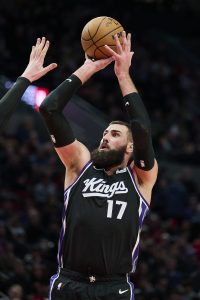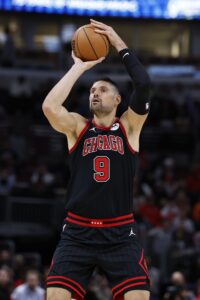While 24 of 30 NBA teams are hard-capped at either the first or second tax apron as a result of one or more roster moves they made this season, the hard cap shouldn’t be an issue for the majority of those 24 teams.
Now that the trade deadline has passed, clubs will generally only be increasing their payrolls with 10-day deals or minor free agent signings, and most teams have more than enough breathing room below their hard caps to comfortably accommodate those moves.
There are a few exceptions though, so we’ll take a closer look in the space below at four teams whose hard caps will – or could – come into play down the stretch.
Before we dive into those specific situations, let’s provide some context: The cap hit for a full-season veteran’s minimum contract for 2024/25 is $2,087,519, which means those deals cost a team $11,997 per day over the course of the 174 days in the regular season. That amount is prorated based on how many days are left in the season — a minimum contract signed with 20 days remaining in the season, for example, would count for $239,945 against the cap.
In the space below, we’ll be referring to how many “days” of minimum deals each team can accommodate. For instance, a team that’s $100K away from its hard cap would be able to squeeze in eight days of a veteran minimum contract (which works out to $95,978), but not nine days (which would be $107,975). That club couldn’t sign a player to a minimum-salary contract until there are just eight days left in the season.
The cap hit for a rookie or a player with one year of NBA service comes in a little lower than the veteran’s minimum, but if the player is a free agent, it still counts as if it’s a veteran’s minimum deal for tax and apron purposes due to the tax variance rule. So a team up against a hard cap won’t be able to sign a rookie free agent any earlier than it could sign a veteran free agent.
The one exception is if the team holds the draft rights to the player — for instance, when the Knicks converted Ariel Hukporti from his two-way contract to a standard NBA deal back in November after drafting him 58th overall last June, Hukporti’s rookie minimum cap hit was equivalent to his tax and apron charge, since he wasn’t signed as a free agent. If one of the teams we’re examining below has the option to take this route, we’ll make note of it.
Let’s dive in…
Dallas Mavericks
- Open roster spots: 1
- Room below hard cap: $171,120
- Veteran minimum days available: 14 ($167,961)
The Mavericks currently have four injured big men (Anthony Davis, Dereck Lively, Daniel Gafford, and Dwight Powell) and would likely welcome the opportunity to sign a free agent center using their open 15-man roster spot. However, their hard cap restrictions seriously complicate matters.
Since they can only accommodate 14 more days of a veteran minimum salary for the rest of the season, the Mavericks essentially have two options:
- Wait until March 31 to sign a free agent.
- Sign a free agent to a 10-day contract at any time, then wait until April 10 to either re-sign that player or add a new free agent.
If they had a good candidate among their draft-rights-held players to fill that 15th roster spot, the Mavericks could accommodate a rookie minimum deal for up to 25 days.
But none of their two-way players fit the bill, and their only draft-and-stash possibility is 20-year-old forward Melvin Ajinca, who is currently playing for ASVEL in France. Bringing Ajinca stateside isn’t a practical solution, so they’ll have to stay patient.
Golden State Warriors
- Open roster spots: 3
- Room below hard cap: $1,372,306
- Veteran minimum days available: 114 ($1,367,685)
On the surface, the Warriors’ restrictions don’t look too bad — 114 days is a lot!
But Golden State is currently carrying just 12 players on standard contracts and must get back to 14 by February 20, since teams can dip below that roster minimum for no more than two weeks at a time (or 28 total days in a season).
A rest-of-season contract signed on Feb. 20 would cover 53 days, which means two rest-of-season deals would total 106 days. If the Warriors go that route, they wouldn’t be able to squeeze in a 15th man until there are just eight days left in the season.
It sounds like the Warriors are more likely to sign a pair of players to 10-day contracts on Feb. 20 — they’ve already reportedly reached a 10-day deal with G League standout Kevin Knox, and I expect a similar agreement with a second player will be reported in the coming days.
Those 10-day contracts would eat up 20 of the club’s remaining 114 days (leaving 94) and would allow Golden State to go another two weeks from March 2-15 with fewer than 14 players under contract. At that point, there would be just 29 days left in the season, so the Warriors could fill all three of their remaining roster spots and stay below the hard cap.
There are other variations in play for the Warriors here. For instance, if they sign a pair of players to back-to-back 10-day contracts on Feb. 20 and Mar. 2, they could dip back down to 12 players for the second half of March before filling their remaining three roster openings with just a couple weeks left in the season. Of course, there’s also no obligation for them to fill that 15th roster spot as soon as they’re eligible to.
It looks like the Warriors will have to go the free agent route. Their two-way players were signed as undrafted free agents and they have no good candidates among their draft-and-stash players to sign to rookie minimum deals unless they want to try to get 2020 second-rounder Justinian Jessup out of his contract in Germany. I don’t see that happening.
New York Knicks
- Open roster spots: 1
- Room below hard cap: $540,127
- Veteran minimum days available: 45 ($539,876)
The Knicks have been unable to sign a 15th man for much of the season and a relatively quiet trade deadline didn’t materially change their situation. The one minor change? Having reduced their team salary by $4,825 in their Jericho Sims/Delon Wright swap, the Knicks can now sign a free agent to a rest-of-season contract on February 28 rather than March 1.
Ten-day signings are also a possibility for New York if the team wants to bring in someone before Feb. 28 or doesn’t want to make a full-season commitment as soon as it legally can.
The Knicks also hold the draft rights to more than a dozen international players and could promote two-way player Kevin McCullar to the 15-man roster on a rookie minimum deal as soon as today, if they want to. But I expect they’ll be looking to add a 15th man who can actually help the team down the stretch or in the playoffs, which means targeting an NBA veteran rather than a rookie.
T.J. Warren, who was with the Knicks in camp in the fall and is putting up big scoring numbers for the Westchester Knicks in the G League, looks like the top candidate to eventually become New York’s 15th man.
Los Angeles Lakers
- Open roster spots: 0
- Room below hard cap: $893,647
- Veteran minimum days available: 74 ($887,795)
Unlike the three teams listed above, the Lakers don’t have an open roster spot to fill and don’t need to wait at all to make another veteran free agent signing. Still, I’m including them here because they’re the only other team within $1MM of a hard cap and there’s a chance they’ll consider another roster move.
For instance, if the Lakers want to bring in another free agent center and waive one of their current players (likely Cam Reddish) next Wednesday, before their post-All-Star schedule begins, a veteran minimum deal would cover 54 days and would carry a cap hit of $647,851. That would leave the team just $245,796 (or 20 days) shy of its hard cap.
Note: Data from Sports Business Classroom was used to confirm team salaries.
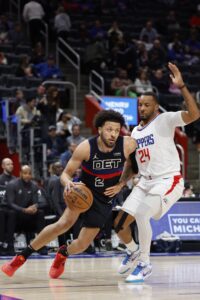 Cunningham is the current favorite for the award, but Powell is a close second.
Cunningham is the current favorite for the award, but Powell is a close second. 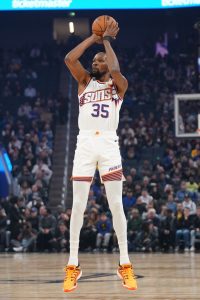 That changed in the days leading up to last Thursday’s trade deadline, when rumors began percolating about Durant’s possible availability. While the former MVP ultimately stayed put,
That changed in the days leading up to last Thursday’s trade deadline, when rumors began percolating about Durant’s possible availability. While the former MVP ultimately stayed put, 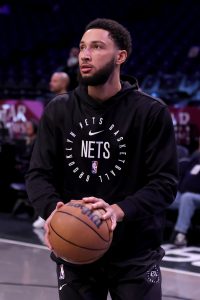 The NBA’s buyout market has been active since the trade deadline and could feature several more moves in the next couple weeks.
The NBA’s buyout market has been active since the trade deadline and could feature several more moves in the next couple weeks.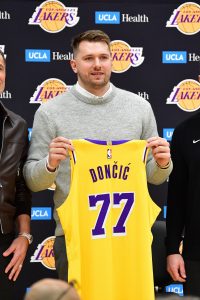 The Lakers and Mavericks shock the NBA (
The Lakers and Mavericks shock the NBA (